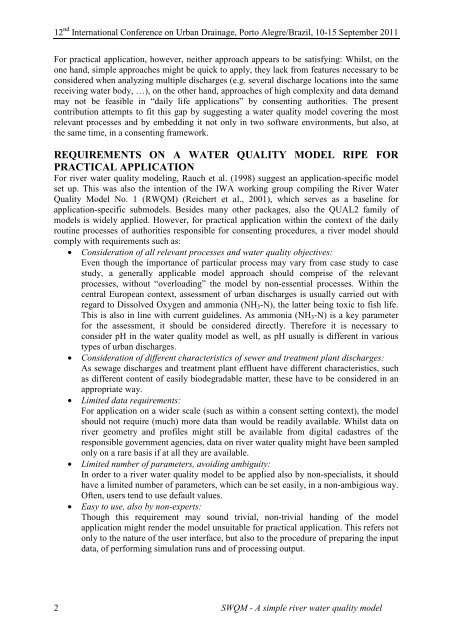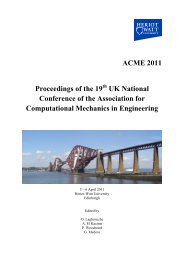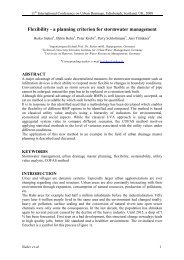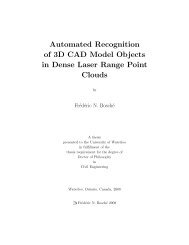SWQM - A simple river water quality model for assessment of urban ...
SWQM - A simple river water quality model for assessment of urban ...
SWQM - A simple river water quality model for assessment of urban ...
You also want an ePaper? Increase the reach of your titles
YUMPU automatically turns print PDFs into web optimized ePapers that Google loves.
12 nd International Conference on Urban Drainage, Porto Alegre/Brazil, 10-15 September 2011<br />
For practical application, however, neither approach appears to be satisfying: Whilst, on the<br />
one hand, <strong>simple</strong> approaches might be quick to apply, they lack from features necessary to be<br />
considered when analyzing multiple discharges (e.g. several discharge locations into the same<br />
receiving <strong>water</strong> body, …), on the other hand, approaches <strong>of</strong> high complexity and data demand<br />
may not be feasible in “daily life applications” by consenting authorities. The present<br />
contribution attempts to fit this gap by suggesting a <strong>water</strong> <strong>quality</strong> <strong>model</strong> covering the most<br />
relevant processes and by embedding it not only in two s<strong>of</strong>tware environments, but also, at<br />
the same time, in a consenting framework.<br />
REQUIREMENTS ON A WATER QUALITY MODEL RIPE FOR<br />
PRACTICAL APPLICATION<br />
For <strong>river</strong> <strong>water</strong> <strong>quality</strong> <strong>model</strong>ing, Rauch et al. (1998) suggest an application-specific <strong>model</strong><br />
set up. This was also the intention <strong>of</strong> the IWA working group compiling the River Water<br />
Quality Model No. 1 (RWQM) (Reichert et al., 2001), which serves as a baseline <strong>for</strong><br />
application-specific sub<strong>model</strong>s. Besides many other packages, also the QUAL2 family <strong>of</strong><br />
<strong>model</strong>s is widely applied. However, <strong>for</strong> practical application within the context <strong>of</strong> the daily<br />
routine processes <strong>of</strong> authorities responsible <strong>for</strong> consenting procedures, a <strong>river</strong> <strong>model</strong> should<br />
comply with requirements such as:<br />
• Consideration <strong>of</strong> all relevant processes and <strong>water</strong> <strong>quality</strong> objectives:<br />
Even though the importance <strong>of</strong> particular process may vary from case study to case<br />
study, a generally applicable <strong>model</strong> approach should comprise <strong>of</strong> the relevant<br />
processes, without “overloading” the <strong>model</strong> by non-essential processes. Within the<br />
central European context, <strong>assessment</strong> <strong>of</strong> <strong>urban</strong> discharges is usually carried out with<br />
regard to Dissolved Oxygen and ammonia (NH3-N), the latter being toxic to fish life.<br />
This is also in line with current guidelines. As ammonia (NH3-N) is a key parameter<br />
<strong>for</strong> the <strong>assessment</strong>, it should be considered directly. There<strong>for</strong>e it is necessary to<br />
consider pH in the <strong>water</strong> <strong>quality</strong> <strong>model</strong> as well, as pH usually is different in various<br />
types <strong>of</strong> <strong>urban</strong> discharges.<br />
• Consideration <strong>of</strong> different characteristics <strong>of</strong> sewer and treatment plant discharges:<br />
As sewage discharges and treatment plant effluent have different characteristics, such<br />
as different content <strong>of</strong> easily biodegradable matter, these have to be considered in an<br />
appropriate way.<br />
• Limited data requirements:<br />
For application on a wider scale (such as within a consent setting context), the <strong>model</strong><br />
should not require (much) more data than would be readily available. Whilst data on<br />
<strong>river</strong> geometry and pr<strong>of</strong>iles might still be available from digital cadastres <strong>of</strong> the<br />
responsible government agencies, data on <strong>river</strong> <strong>water</strong> <strong>quality</strong> might have been sampled<br />
only on a rare basis if at all they are available.<br />
• Limited number <strong>of</strong> parameters, avoiding ambiguity:<br />
In order to a <strong>river</strong> <strong>water</strong> <strong>quality</strong> <strong>model</strong> to be applied also by non-specialists, it should<br />
have a limited number <strong>of</strong> parameters, which can be set easily, in a non-ambigious way.<br />
Often, users tend to use default values.<br />
• Easy to use, also by non-experts:<br />
Though this requirement may sound trivial, non-trivial handing <strong>of</strong> the <strong>model</strong><br />
application might render the <strong>model</strong> unsuitable <strong>for</strong> practical application. This refers not<br />
only to the nature <strong>of</strong> the user interface, but also to the procedure <strong>of</strong> preparing the input<br />
data, <strong>of</strong> per<strong>for</strong>ming simulation runs and <strong>of</strong> processing output.<br />
2 <strong>SWQM</strong> - A <strong>simple</strong> <strong>river</strong> <strong>water</strong> <strong>quality</strong> <strong>model</strong>













